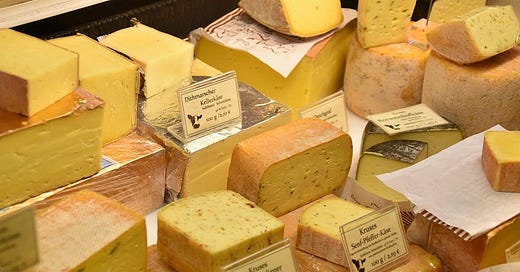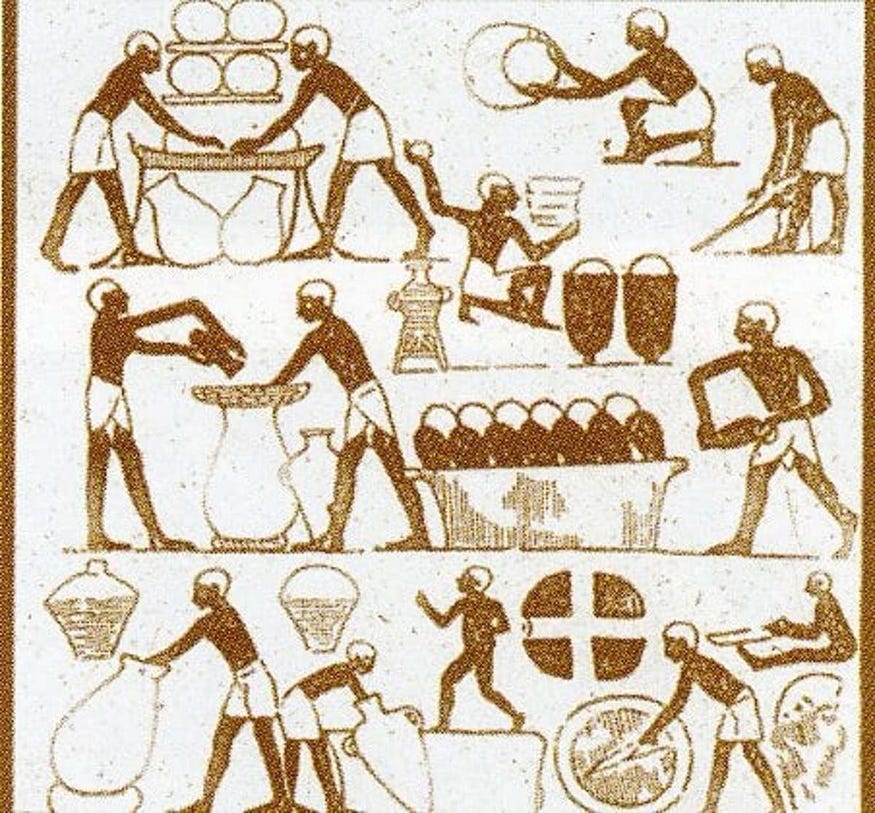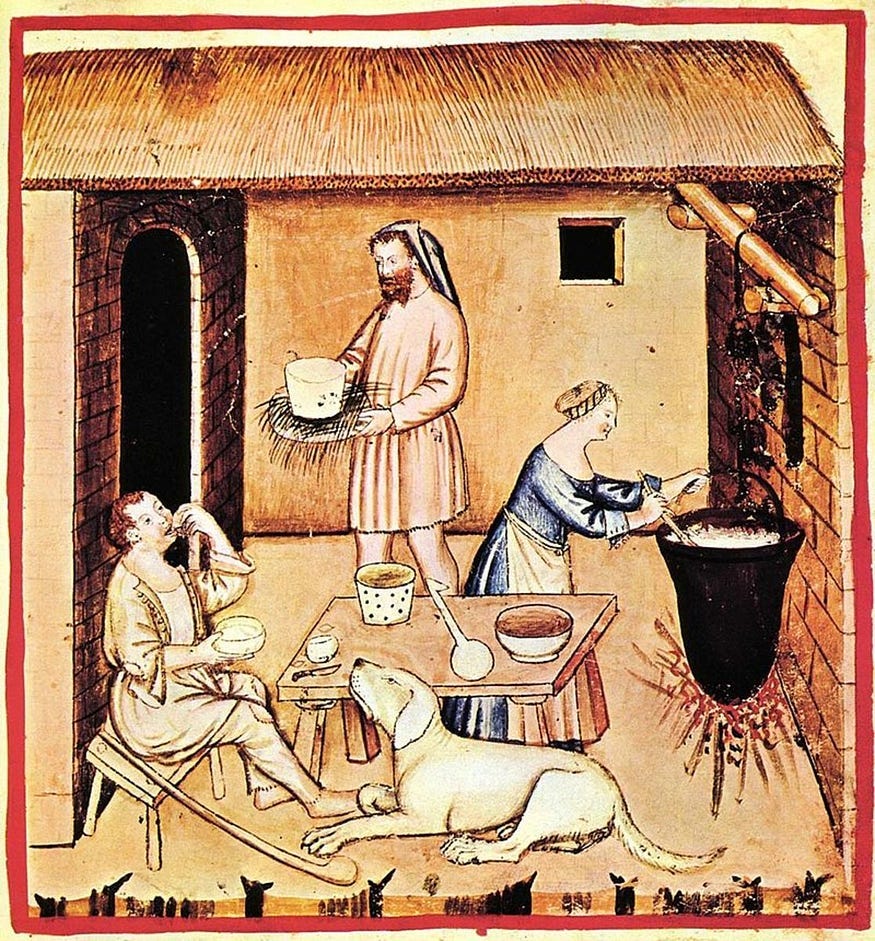Origins of Cheese
Cheese, still a favorite dairy treat for many, has been a part of humanity’s food culture for thousands of years. But its exact origins are difficult to pin down.
However, we do know that milk-producing animals like sheep, goats, and cows were likely first domesticated in the Middle East sometime between 10,000 and 11,000 years ago—a crucial step on the path to cheesemaking.
But how—and when—was the discovery of cheese made?
Archaeological Evidence Helps Create a Timeline
A number of important archaeological discoveries have helped to give us a better idea of when cheese production might have begun.
Shards from holed pottery found in Switzerland dating back to 8,000 years ago are speculated to have been used as a cheese strainer.
More than 7,000 years old, sieves from Kujawy, Poland, and Croatia’s Dalmatian Coast provide the earliest direct evidence for cheesemaking. Significantly, the find from Croatia contained traces of the dried remnants of what appeared to have been cheese—and chemical analysis supported this conclusion.
The earliest written references to cheese turned up in cuneiform texts from the time of Sumeria’s Third Dynasty of Ur (c. 2112–2004 BC).
Linear B tablets from Late Bronze Age-era Crete display an inventory record that mentions—among other things—cheese.
Interestingly, 3500-year-old mummies discovered in China’s Xiaohe Cemetery were apparently covered in cheese before their burial—possibly a gift for them to take into the afterlife.
An analysis of the remnants of this substance revealed strains of bacteria such as Lactobacillus kefiranofaciens and L. helveticus, variants of which are still found in today’s kefir, a fermented milk which can also be used to create a soft cheese.
“It’s the oldest cheese DNA in the world,” said geneticist Qiaomei Fu.
Cheese in Ancient Egypt
In a Saqqara necropolis, the tomb of Ptahmes — a high-ranking Egyptian official during the time of pharaohs Seti I and Ramesses II — was found to contain jars of a “solidified whitish mass,” which turned out to be cheese dating back to 3,200 years ago.
“We know it was made mostly from sheep’s and goat’s milk,” said Dr. Enrico Greco of the University of Catania.
Another Ancient Egyptian tomb (this one from 2900 BC) held the remains of a funeral meal which included cheese.
Further proving the Egyptians’ love of this food are hieroglyphics depicting the practice of cheesemaking. These were found in tombs dating to approximately 2000 BC.
It’s believed that early cheeses were similar in taste and texture to modern-day feta or cottage cheese.
Cheesemaking in Other Parts of the Ancient World
There are two chapters devoted to the topic of cheese in Pliny the Elder’s Natural History (AD 77). In them, he highlights the variety of cheeses made and enjoyed by those living in the Roman Empire, such as hard, aged cheese and soft cheeses.
Homer’s The Odyssey (written around the 8th or 7th centuries BC) features a character named Polyphemus, who, in addition to being one of the antagonists of the epic poem, is also a cheesemaker.
“We soon reached his cave, but he was out shepherding, so we went inside and took stock of all that we could see. His cheese-racks were loaded with cheeses, and he had more lambs and kids than his pens could hold (…) When he had so done he sat down and milked his ewes and goats, all in due course, and let each of them have her own young. He curdled half the milk and set it aside in wicker strainers.”
There’s also a reference to the process in The Iliad:
“Fig rennet coagulating the milk quickly.”
This treat was popular in Ancient Rome and new types began to emerge as different locales across the empire developed their own cheesemaking traditions. By Julius Caesar’s time, hundreds of varieties of cheese existed and were traded across the vast territory of the Romans.
Caseus aridus—dried cheese—was frequently consumed by Roman soldiers.
In Ancient Greece, feta was what they liked to eat.
In the Far East, the Mongolians utilized yak’s milk to make the hard, sun-dried cheese they referred to as byaslag.
How Was Cheese Discovered?
One question that has never been answered definitively is how cheese was first discovered.
The most popular theory today is that this discovery was made purely by accident.
As one ancient Arab legend tells it, a traveling merchant carried his milk in a pouch made from the stomach of a sheep out into the desert. The stomachs of ruminant mammals, such as sheep, contain rennet—enzymes essential to making milk curdle.
And so the rennet combined with both the milk and the heat of the hot desert sun caused the liquid to separate into curds and whey, creating a flavor and texture that the merchant found appetizing.
Whether or not this specific tale is accurate, the idea makes sense. Additionally, the practice of salting curdled milk to preserve it would have furthered this process along. It is also believed that Asian travelers introduced cheesemaking to Europe.
Cheesemaking in the Americas
Cheesemaking seems to have been a practice in the pre-Columbian Americas as well. The Inca of South America domesticated llamas and, according to conquistadors, they would use llama milk to make cheese. Other Andean cultures reportedly did the same.
In 1620, the Pilgrims, traveling to North America on the Mayflower, brought cheese with them, among other supplies. Cheesemaking in the New World started to take off in the colonies of Massachusetts, Rhode Island, and Connecticut, as many dairymen lived there.
Over time, as New Englanders settled in New York and Ohio (the western portion of which would earn the nickname “cheesedom”), these states took over as the cheese center of the young nation and would remain so for approximately 150 years.
However, this would change as the 19th century progressed. As more and more settlers moved west to Wisconsin—including immigrants from Norway, Switzerland, and Germany—a farmstead cheese industry rose up there, which continued to grow with help from Ohio, New York and Europe—all of which provided some supplies and equipment.
Wisconsin wasn’t always famous for cheese, though. Initially, the state became well known for growing crops like wheat, hops, and barley, and was referred to as the “granary of the north” during the Civil War.
Records show that 400,283 lbs of cheese came from Wisconsin farms in 1849. The state’s earliest factory was a Limburger plant that opened up in 1868. By 1910, Wisconsin had surpassed both New York and Ohio in cheese production.

Familiar Cheeses of Today
Cheesemaking frequently took place in monasteries in Europe during the Middle Ages and the Renaissance.
Interestingly, many of the most popular and familiar cheeses of the modern day have only been around for roughly the past 500 years or so. Cheddar, for example, has been made since at least the 16th century.
Historical records reveal that the earliest mentions of Parmesan, Gouda, and Camembert are from 1597, 1697, and 1791, respectively. Swiss cheese production, on the other hand, might have begun as early as 1300 in Switzerland.
Amazingly, there are more than 2,000 types of cheese in the world today and the popularity of this dairy treat shows no signs of diminishing.
If you would like to support my work and make a donation: Buy Me a Coffee
Sources
(This article was originally published on HubPages)







